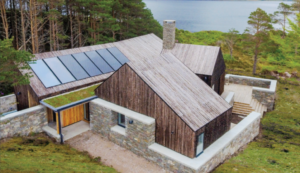Great Britain: Zero Carbon or Nearly Zero Carbon?
May 13, 2013
In December 2006, the UK Government set a new policy that all new homes in England would be ‘zero carbon’ from 2016 and introduced an initiative called the Code for Sustainable Homes (CSH), which would allow ratings to measure different levels of compliance. Although initially confusing, the term ‘Carbon’ in fact means anthropogenic Carbon Dioxide emissions. Although these ratings did not specifically promote solar thermal, it was most difficult to comply with the ratings without renewable technologies on the building. Ever since, several governmental announcements brought delay and doubts into this far-reaching climate protection policy. The photo shows a low carbon building in the town of Rothwell, Northamptonshire that achieves reductions of 65 % compared to Part L of the building regulations 2006.
The original definition of zero carbon was for the building to achieve a 70% reduction in emissions compared to current homes; this required a combination of energy efficiency and on, or near-site, renewables. The remaining 30% CO2 emissions, plus an amount for non-regulated electricity use such as by appliances, would have been supplied by directly connected renewables. In fact so far, only very few of the highest rating homes have ever been built with the building industry complaining the rules were too strict.
Much of these activities arise from the European Directive 2010/31/EU. This states that by 2021, all new buildings shall be ‘nearly zero-energy consumption buildings’. New buildings occupied and owned by public authorities shall comply with the same criteria by 2019. Member states are required to put in place national plans, including intermediate plans by 2015, which contain:
- the application in practice of the definition of nearly zero-energy buildings;
- the intermediate targets for improving the energy performance of new buildings by 2015;
- information on the policies and financial measures adopted to encourage improving the energy performance of buildings.
In 2011, the UK Government Treasury’s ‘Budget’s Plan for Growth’ announced details of the 2016 zero carbon new homes policy to include only the emissions covered by the Building Regulations (i.e. heating, fixed lighting, hot water and building services). And so emissions from cooking or from plug-in appliances such as computers and televisions would not be included. In 2012, the UK Government consulted on changes to Part L of the Building Regulations applying to England and Wales due for publication in 2013 but also announced that they would undertake a radical and fundamental review of the entire framework of Building Regulations and voluntary housing standards. So this now brought delay and doubts into the original zero carbon policies.
Zero carbon policies differ between the regions of England, Scotland, Wales and Northern Ireland. There are different Building Regulations and so each region will be at different stage. For Wales, the target was originally more ambitious than England but in Northern Ireland it was slower. For Scotland the informal targets are aimed at 2016/2017.
In February 2013, the UK government opposition called for a re-affirmation of policy to make all new English homes zero carbon by 2016. Many in the industry see there is a delay to the announcements of the Part L Building Regulations for England and Wales. But the Department of Communities and Local Government (DCLG) has argued there has been no delay. There were also concerns that the rules will be further reducing to meet the already uncertain definition of zero carbon. The Government responded in March 2013 with its Budget, in which the commitment to zero carbon homes from 2016 was re-affirmed. Furthermore there was a commitment to publish a detailed plan setting out Government’s response to the 2012 building regulations consultation. Also by the summer recess of 2013, a commitment was given to consult on the next steps for the zero carbon home policy, including the means for delivering allowable solutions.
So far the zero carbon target has been explained in three parts:
- A high level of insulation and air tightness known as the Fabric Energy Efficiency Standard (FEES);
- Efficient heating, hot water and lighting known as the Carbon Compliance Standard (CCS);
- The remaining emissions to be dealt with via ’Allowable Solutions’.
It is this last item the ‘Allowable Solutions’ that is most uncertain as it may allow developers to pay into a fund that would help pay for emission reductions off site. This would undermine the hopes of the solar thermal industry that benefit most from restraints to on-site CO2 emissions. Paul King, Chief Executive of industry association UK Green Building Council confirms the problem “By providing the clarity so urgently needed on changes to the building regulations and confirming its support for zero carbon homes, Government could inject confidence into a sector with huge growth potential for the UK economy. Unfortunately the Chancellor appears intent on blocking a key green policy with widespread industry support and once again undermining the Coalition’s claim to be the greenest Government ever.”
Further details can be found at http://www.zerocarbonhub.org which has lead responsibility for delivering homes to zero carbon standards by 2016.
In April 2013, the British Consultancy BSRIA Limited published a multi-client study on UK Solar thermal (see attached document). They indicate a “positive outlook for the UK solar thermal market up to 2016, even though in view of last year’s collapse the absolute volume size of the market is anticipated to remain under 2008 volumes until the end of 2014.” They observe that at current CO2 reduction level of 25% (or Level 3 of the CSH) designers have several options to reach this including using heat pumps or boilers with efficient ventilation with increased wall cavity insulation. These measures have all been reported to be frequently preferred to solar thermal systems.
BSRIA confirm that presently in new buildings, solar thermal is currently found on less than 10% of builds. This can be explained in part as there are no legal obligations specific to fit renewables on buildings. So the refurbishment market is also important since “the number of housing completion is forecast to remain under 140,000 units a year until 2016 ….. It is estimated that at least 70% of the UK’s housing stock likely to exist in 2050 has already been built”.
More information:
UK Green Building Council: http://www.ukgbc.org
BSRIA: http://www.bsria.co.uk/
http://www.zerocarbonhub.org


